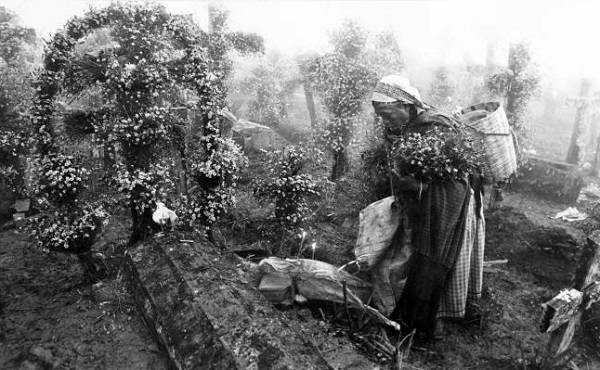Day of the Dead is an important Mexican holiday that celebrates and honors deceased loved ones. In Mexico, the celebration is held from October 31 to November 2nd, coinciding with the Catholic feast days of All Saints and All Souls, but the festival’s origins are rooted in a combination of elements of indigenous beliefs and Catholic teachings.
Over time it has evolved, adding some new ideas and practices, ultimately transcending its origins to evolve into the truly Mexican holiday that is celebrated today as Día de Muertos or Hanal Pixan in the Maya area.
The celebration of the festival Dia de los Muertos (alternately known as Dia de Muertos and Dia de Todos Santos) corresponds to the observance of Hallowe’en (or the Feast of All Saints and All Souls) in other countries with significant Catholic populations.

Mixquic, Mexico 1978 (El Universal)
When the Spanish conquistadors arrived in the sixteenth century, they introduced the Catholic faith to the indigenous people of Mesoamerica and tried to stamp out their gods and native religion. They were only moderately successful, and the Catholic teachings intermingled with the native beliefs to create new traditions.
The preHispanic festival related to death and celebrating the ancestors was moved to coincide with the Catholic holidays of All Saints Day (November 1st) and All Souls Day (November 2nd), and although it is considered a Catholic holiday, it retains elements of the pre-Hispanic celebrations.
The incorporation of Christian syncretism is most evident in the altars (altares de muertos), which draw directly from Columbian translation of symbolism. The incorporation of Christian symbols (such as the crucifix) and traditional Mexican imagery is to be expected in these altars.

Traditional prehispanic day of the dead altar (Pinterest)

Contemporary Day of The Dead altar with Crucifix and other Christian elements (Google)
Syncretism is also evident in the dates of the celebration, as November 1st and 2nd coincide with All Saints Day and All Souls Day, both Christian holidays. It is often evident in cases such as this (a Christian power coming into an indigenous, pagan civilization), that Christian holidays are overlaid into traditional celebrations and incorporated into previous cultural practices as a means of more easily assimilating Christian culture.
Dia de los Muertos eclipses all other religious holidays in Mexico and serves as a link not only between life and death, but also between Mexico’s past and present. No other festival in Mexico, whether civic (Día del Grito or Cinco de Mayo) or religious, comes close to the artistic and folkloric significance of these feast days.

Day of the Dead parade in Mexico City 2017 (Photo: Google)
Far from being a relic of the past, Dia de los Muertos’ maintains a vital psychological appeal in contemporary Mexico. The holiday is celebrated as both an intimately private and communally public activity.
Globalization might appropiate certain aspects of public observance for the lucrative tourist trade, but Mexican migration into the United States promises to expand the scope of Dia de los Muertos observance. The demographic expansion of Mexicans into divergent regions of the United states may well serve to create new fusions and variations of the traditions of Dia de los Muertos outside Mexico.

Monumental altar in Mexico City (Google)
Day of the Dead is a continually evolving tradition, and Mexico’s influence in other countries has enhanced the overlap that exists between Halloween, All Saints Day and Day of the Dead.
More and more people are celebrating Día de Muertos the Mexican way all around the world, taking the opportunity to honor and remember their deceased loved ones by creating altars and adopting other Day of the Dead festivities´customs and traditions.
Alejandro Azcárate / SMT Newsroom with information from:

